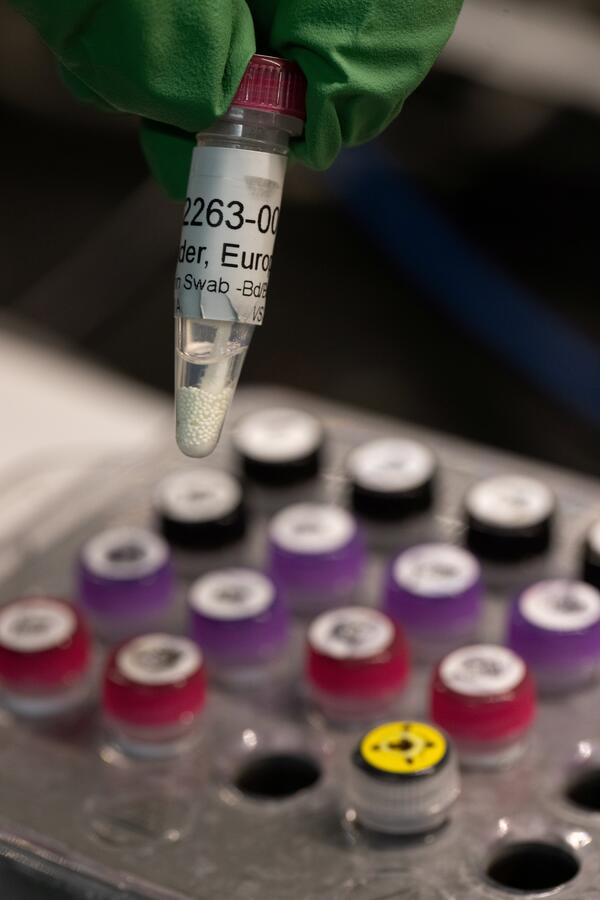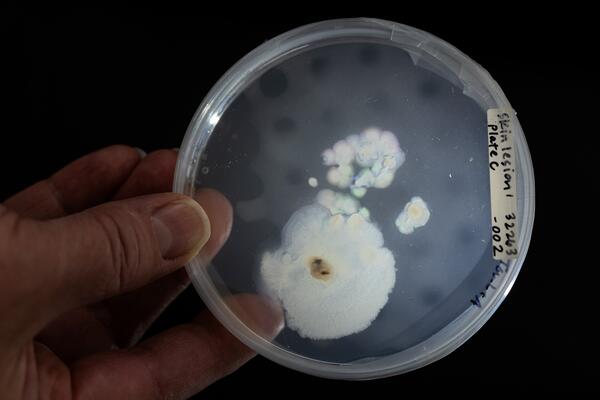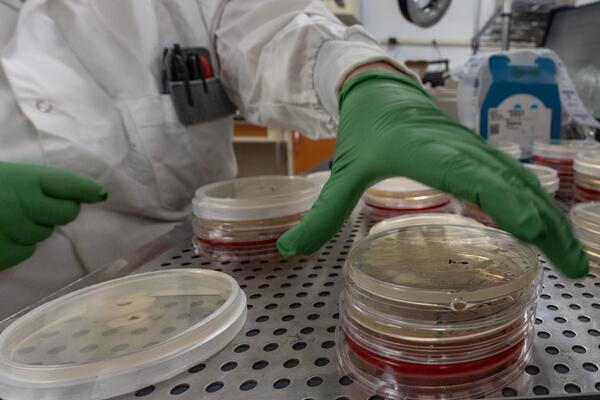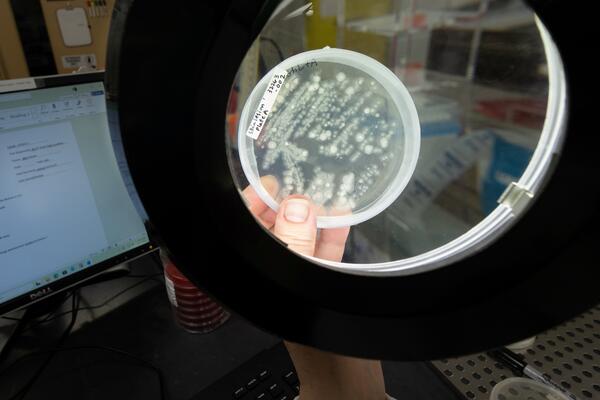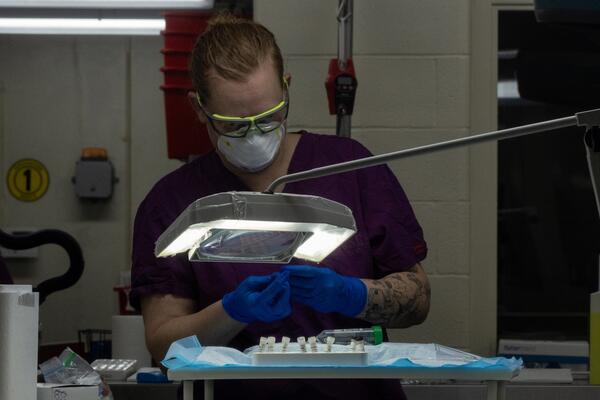A USGS scientist prepares to analyze a skin swab from a salamander to investigate for potential pathogens.
Multimedia
Search here for some of our available field imagery and videos.
Images
A USGS scientist prepares to analyze a skin swab from a salamander to investigate for potential pathogens.
A USGS scientist examines a skin sample from a salamander as part of a study to investigate for potential pathogens.
A USGS scientist examines a skin sample from a salamander as part of a study to investigate for potential pathogens.
A USGS scientist reaches for a microbiological plate with cultures from salamander skin to investigate for potential pathogens.
A USGS scientist reaches for a microbiological plate with cultures from salamander skin to investigate for potential pathogens.
A USGS scientist examines microorganisms from salamander skin to investigate for potential pathogens.
A USGS scientist examines microorganisms from salamander skin to investigate for potential pathogens.
Thanksgiving Banner_ Holiday hours banner "The USGS National Wildlife Health Center will be closed Thursday, Nov 27, 2025 and have reduced staffing on Friday, Nov 28, 2025 for the Thanksgiving holiday which may affect your shipments, submission processing and results reporting. Please plan your specimen collections and shipments accordingly for r
Thanksgiving Banner_ Holiday hours banner "The USGS National Wildlife Health Center will be closed Thursday, Nov 27, 2025 and have reduced staffing on Friday, Nov 28, 2025 for the Thanksgiving holiday which may affect your shipments, submission processing and results reporting. Please plan your specimen collections and shipments accordingly for r
A USGS scientist examines salamanders as part of a study to investigate for potential pathogens.
A USGS scientist examines salamanders as part of a study to investigate for potential pathogens.
Videos
 Collecting a skin swab for white-nose syndrome surveillance (AD)
Collecting a skin swab for white-nose syndrome surveillance (AD)
Collecting a skin swab for white-nose syndrome surveillance (AD)
Collecting a skin swab for white-nose syndrome surveillance (AD)This video shows the proper technique for collecting a skin swab from a bat that is either roosting in place or is manually restrained for white-nose syndrome surveillance.
Collecting a skin swab for white-nose syndrome surveillance (AD)
Collecting a skin swab for white-nose syndrome surveillance (AD)This video shows the proper technique for collecting a skin swab from a bat that is either roosting in place or is manually restrained for white-nose syndrome surveillance.
 Approved euthanasia methods for bats (Microchiroptera)
Approved euthanasia methods for bats (Microchiroptera)
Approved euthanasia methods for bats (Microchiroptera)
Approved euthanasia methods for bats (Microchiroptera)This video shows the proper procedure for performing cervical dislocation on a bat with clinical signs of white-nose syndrome to be submitted to a diagnostic laboratory for evaluation.
Approved euthanasia methods for bats (Microchiroptera)
Approved euthanasia methods for bats (Microchiroptera)This video shows the proper procedure for performing cervical dislocation on a bat with clinical signs of white-nose syndrome to be submitted to a diagnostic laboratory for evaluation.
 Approved euthanasia methods for bats (Microchiroptera)—Audio-Described
Approved euthanasia methods for bats (Microchiroptera)—Audio-Described
Approved euthanasia methods for bats (Microchiroptera)—Audio-Described
Approved euthanasia methods for bats (Microchiroptera)—Audio-DescribedThis video shows the proper procedure for performing cervical dislocation on a bat with clinical signs of white-nose syndrome to be submitted to a diagnostic laboratory for evaluation.
Approved euthanasia methods for bats (Microchiroptera)—Audio-Described
Approved euthanasia methods for bats (Microchiroptera)—Audio-DescribedThis video shows the proper procedure for performing cervical dislocation on a bat with clinical signs of white-nose syndrome to be submitted to a diagnostic laboratory for evaluation.
 Collecting a bat skin biopsy for white-nose syndrome surveillance
Collecting a bat skin biopsy for white-nose syndrome surveillance
Collecting a bat skin biopsy for white-nose syndrome surveillance
Collecting a bat skin biopsy for white-nose syndrome surveillanceThis video demonstrates the proper procedure for collecting a skin biopsy from a bat when conducting white-nose syndrome surveillance.
Collecting a bat skin biopsy for white-nose syndrome surveillance
Collecting a bat skin biopsy for white-nose syndrome surveillanceThis video demonstrates the proper procedure for collecting a skin biopsy from a bat when conducting white-nose syndrome surveillance.
 UV Screening for Bat White-Nose Syndrome Surveillance
UV Screening for Bat White-Nose Syndrome Surveillance
UV Screening for Bat White-Nose Syndrome Surveillance
UV Screening for Bat White-Nose Syndrome SurveillanceLong-wave ultraviolet (UV) light can be used to detect orange fluorescence associated with white-nose syndrome (https://www.usgs.gov/centers/nwhc/science/white-nose-syndrome-surveillance) on bat skin.
UV Screening for Bat White-Nose Syndrome Surveillance
UV Screening for Bat White-Nose Syndrome SurveillanceLong-wave ultraviolet (UV) light can be used to detect orange fluorescence associated with white-nose syndrome (https://www.usgs.gov/centers/nwhc/science/white-nose-syndrome-surveillance) on bat skin.
 Collecting a bat skin biopsy for white-nose syndrome surveillance (AD)
Collecting a bat skin biopsy for white-nose syndrome surveillance (AD)
Collecting a bat skin biopsy for white-nose syndrome surveillance (AD)
Collecting a bat skin biopsy for white-nose syndrome surveillance (AD)This video demonstrates the proper procedure for collecting a skin biopsy from a bat when conducting white-nose syndrome surveillance.
Collecting a bat skin biopsy for white-nose syndrome surveillance (AD)
Collecting a bat skin biopsy for white-nose syndrome surveillance (AD)This video demonstrates the proper procedure for collecting a skin biopsy from a bat when conducting white-nose syndrome surveillance.
Audio
Outstanding in the Field (Ep 3): Chronic Wasting Disease - Oh, Deer
Outstanding in the Field (Ep 3): Chronic Wasting Disease - Oh, DeerThe USGS Ecosystems Mission Area brings you Outstanding in the Field, a series of stories about our science, our adventures, and our efforts to better understand our fish and wildlife and the ecosystems that support them.
Outstanding in the Field (Ep 3): Chronic Wasting Disease - Oh, Deer
Outstanding in the Field (Ep 3): Chronic Wasting Disease - Oh, DeerThe USGS Ecosystems Mission Area brings you Outstanding in the Field, a series of stories about our science, our adventures, and our efforts to better understand our fish and wildlife and the ecosystems that support them.


